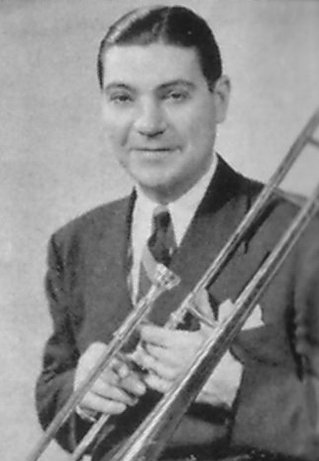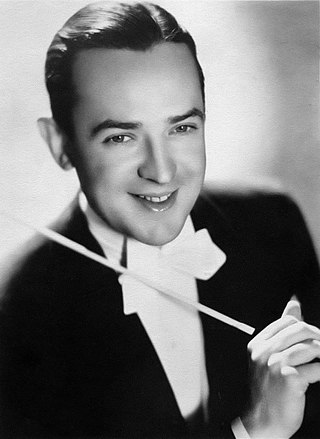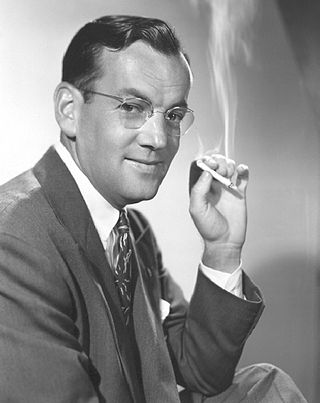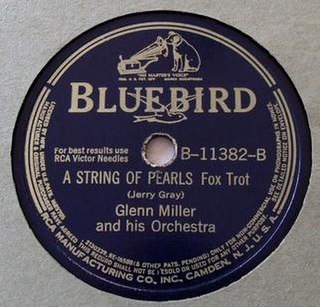
125 Jazz Breaks for Trombone is a 1927 folio or songbook of compositions for trombone by Glenn Miller. The jazz breaks were included in a songbook published by the Melrose Brothers in Chicago and a UK edition by Herman Darewski.

125 Jazz Breaks for Trombone is a 1927 folio or songbook of compositions for trombone by Glenn Miller. The jazz breaks were included in a songbook published by the Melrose Brothers in Chicago and a UK edition by Herman Darewski.
The songbook was copyrighted in 1927 as Glenn Miller's 125 Jazz Breaks for Trombone by the Melrose Brothers Music Company: The House That Blues Built, 177 North State Street, Chicago, Illinois. The score was published in the UK in London by Herman Darewski Music Publishing Co., in 1941, established by the Polish-born composer and conductor. [1] The songbook was softcover and measured 6 3/4 X 10 inches. It consisted of 22 pages. Glenn Miller is pictured on the cover in a black and white photograph. The cover illustration is signed with the initials N.E.K. The rear cover has ads for other Melrose Brothers Music Company publications including ones for Dixieland, Book of Blues, Benny Goodman, Louis Armstrong, and Jelly Roll Morton.
In the publisher's forward it discussed the art of playing jazz, mentioning "Glenn Miller, feature trombonist of Ben Pollack's Victor Recording Orchestra, and author of this book, is recognized everywhere as a finished artist." The back cover contained the description: "Glenn Miller is a feature trombonist with Ben Pollack's Victor Recording Orchestra. Professional musicians everywhere recommend this book. Price: $1.00." The sheet music was advertised in the 1928 Billboard, Volume 40, Page 202. "The Jazz Breaks are works of recognized Jazz artists who have made national reputations. JAZZ BREAKS. Benny Goodman's 125 Jazz Breaks for Sax and Clarinet. $1.00. GLENN MILLER'S 125 Jazz Breaks for Trombone. $1.00." [2] An ad for the sheet music also appeared in the 1928 Metronome, Volume 44, Page 42.
The songbook contained the sheet music for 125 jazz breaks or improvisations for trombone with piano accompaniment in different keys.
The Melrose Bros. Music Company was founded by Walter Melrose and Lester Melrose. Melrose Music also published Louis Armstrong's 125 Jazz Breaks for Cornet and Benny Goodman's 125 Jazz Breaks for the Saxophone and Clarinet in 1928. [3] These folios were also republished by Herman Darewski in the UK. [4]
There are no recordings of the trombone solos.


Benjamin David Goodman was an American clarinetist and bandleader known as the "King of Swing".

A big band or jazz orchestra is a type of musical ensemble of jazz music that usually consists of ten or more musicians with four sections: saxophones, trumpets, trombones, and a rhythm section. Big bands originated during the early 1910s and dominated jazz in the early 1940s when swing was most popular. The term "big band" is also used to describe a genre of music, although this was not the only style of music played by big bands.

Alton Glen Miller was an American big band founder, owner, conductor, composer, arranger, trombone player, and recording artist before and during World War II, when he was an officer in the US Army Air Forces. Glenn Miller and His Orchestra was one of the most popular and successful bands of the 20th century and the big band era. His military group, the Major Glenn Miller Army Air Forces Orchestra, was also popular and successful.

Weldon Leo "Jack" Teagarden was an American jazz trombonist and singer. According to critic Scott Yannow of Allmusic, Teagarden was the preeminent American jazz trombone player before the bebop era of the 1940s and "one of the best jazz singers too". Teagarden's early career was as a sideman with the likes of Paul Whiteman and lifelong friend Louis Armstrong.

James Francis Dorsey was an American jazz clarinetist, saxophonist, composer and big band leader. He recorded and composed the jazz and pop standards "I'm Glad There Is You " and "It's The Dreamer In Me". His other major recordings were "Tailspin", "John Silver", "So Many Times", "Amapola", "Brazil ", "Pennies from Heaven" with Bing Crosby, Louis Armstrong, and Frances Langford, "Grand Central Getaway", and "So Rare". He played clarinet on the seminal jazz standards "Singin' the Blues" in 1927 and the original 1930 recording of "Georgia on My Mind", which were inducted into the Grammy Hall of Fame.

Irving Milfred Mole known professionally as Miff Mole, was an American jazz trombonist and band leader. He is generally considered one of the greatest jazz trombonists and credited with creating "the first distinctive and influential solo jazz trombone style."

Ben Pollack was an American drummer and bandleader from the mid-1920s through the swing era. His eye for talent led him to employ musicians such as Benny Goodman, Jack Teagarden, Glenn Miller, Jimmy McPartland, and Harry James. This ability earned him the nickname the "Father of Swing".
The swing era was the period (1933–1947) when big band swing music was the most popular music in the United States. Though this was its most popular period, the music had actually been around since the late 1920s and early 1930s, being played by black bands led by such artists as Duke Ellington, Jimmie Lunceford, Bennie Moten, Cab Calloway, Earl Hines, and Fletcher Henderson, and white bands from the 1920s led by the likes of Jean Goldkette, Russ Morgan and Isham Jones. An early milestone in the era was from "the King of Swing" Benny Goodman's performance at the Palomar Ballroom in Los Angeles on August 21, 1935, bringing the music to the rest of the country. The 1930s also became the era of other great soloists: the tenor saxophonists Coleman Hawkins, Ben Webster and Lester Young; the alto saxophonists Benny Carter and Johnny Hodges; the drummers Chick Webb, Gene Krupa, Jo Jones and Sid Catlett; the pianists Fats Waller and Teddy Wilson; the trumpeters Louis Armstrong, Roy Eldridge, Bunny Berigan, and Rex Stewart.

Carl Charles Fontana was an American jazz trombonist. After working in the big bands of Woody Herman, Lionel Hampton, and Stan Kenton, he devoted most of his career to playing music in Las Vegas.
Enoch Henry Light was an American classically trained violinist, danceband leader, and recording engineer. As the leader of various dance bands that recorded as early as March 1927 and continuing through at least 1940, Light and his band primarily worked in various hotels in New York. For a time in 1928 he also led a band in Paris. In the 1930s Light also studied conducting with the French conductor Maurice Frigara in Paris.
Murray McEachern was a Canadian jazz trombonist and alto saxophonist, perhaps best known for having played trombone for Benny Goodman from 1936 to 1937. McEachern is also remembered for playing both the trombone and alto saxophone for the Casa Loma Orchestra from 1937 to 1941.

Ernesto Caceres was an American jazz saxophonist born in Rockport, Texas. He was a member of the Glenn Miller Orchestra from 1940–1942.
Sterling Belmont "Bozo" Bose was an American jazz trumpeter and cornetist who also marked a twice occurrence of double instrumentation, with a 1935-1938 Glenn Miller trumpet-violin and then a trombone with a 1937-1947 various album. His style was heavily influenced by Bix Beiderbecke and changed little over the course of his life.
Joseph Anthony "Fud" Livingston was an American jazz clarinetist, saxophonist, arranger, and composer.

Between 1938 and 1944, Glenn Miller and His Orchestra released 266 singles on the monaural ten-inch shellac 78 rpm format. Their studio output comprised a variety of musical styles inside of the Swing genre, including ballads, band chants, dance instrumentals, novelty tracks, songs adapted from motion pictures, and, as the Second World War approached, patriotic music.

"Room 1411" is a 1928 instrumental composed by Glenn Miller and Benny Goodman and released as a Brunswick 78 by Benny Goodman's Boys. The song was Glenn Miller's first known composition and was an early collaboration between Glenn Miller and Benny Goodman, who would become the most successful bandleaders of the Big Band Era during the 1930s and 1940s.

"A String of Pearls" is a 1941 song composed by Jerry Gray with lyrics by Eddie DeLange. It was notably recorded by Glenn Miller and His Orchestra on RCA Bluebird that November, becoming a #1 hit. The song is a big band and jazz standard.
Walter Melrose was a music publisher and lyricist in the 1920s and 1930s.

"Wang Wang Blues" is a 1920 jazz composition written by Henry Busse, Gussie Mueller, and Theron E. "Buster" Johnson, with lyrics by Leo Wood. The song was released as a 78 single by Paul Whiteman and his Orchestra featuring Henry Busse on trumpet. The song is a pop and jazz standard.